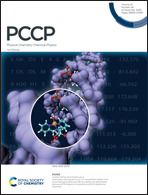Influence of the N atom and its position on electron photodetachment of deprotonated indole and azaindole†
Abstract
Electron photodetachment of cold deprotonated indole and azaindole anions has been studied by use of a mass-selective photofragmentation spectrometer capable of negative ion and neutral particle detection. The electron affinities of the indolyl radical and the 5-, 6- and 7-azaindolyl radicals have been measured with an uncertainty of less than 0.002 eV. The presence of the nitrogen atom in the six-membered ring of the azaindolide anions stabilises the electron by 0.3 to 0.4 eV, i.e. about 10–15%, compared to the indolide anion. No fragmentation was observed in either the anionic or radical forms of the species studied. The appearance of dipole-bound states in the spectra of deprotonated 6- and 7-azaindole anions allowed us to analyse the vibrational structure of the neutral 6- and 7-azaindolyl radicals produced following photodetachment. Although no dipole-bound states were clearly identified for deprotonated indole or 5-azaindole, the shape of the photodetachment threshold suggests the presence of a very weakly dipole-bound state or dipole resonance, which cannot be resolved with our laser resolution.



 Please wait while we load your content...
Please wait while we load your content...